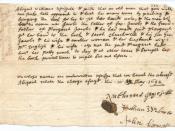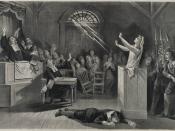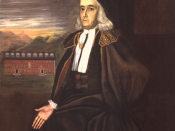The Crucible takes place in a very intolerant setting. The Puritans in Salem, Massachusetts uphold a strict theocratic society. In a theocracy, the community is governed by God and the laws revolve around what God says to be right or wrong, meaning people can be punished for sinning. Anyone who strays away from the set ideals or beliefs is punished and persecuted accordingly. The weakness in such societies is that the people in authoritative positions can become easily corrupted. In The Crucible, Arthur Miller shows how intolerance can lead to persecution through the characters of Danforth and Abigail and in his purpose for writing this play.
Deputy Governor Danforth is not a tolerant man. He does not allow outspoken behavior in his courtroom, especially if it is against the court. His dictator-like status is seen at the beginning of the trials in Salem. "This is a court of law, Mister.
I'll have no effrontery here!" (Miller 1254). Danforth cannot stand any deviation from what he believes to be right and true. Throughout the play, Danforth grows more prejudiced against witches. His character is led by the words of Abigail and the other girls. "In an ordinary crime, how does one defend the accused? One calls up witnesses⦠But witchcraft isâ¦an invisible crime, is it not? Therefore, we must rely upon her victims." (1255). When a finger is pointed at a supposed witch, Danforth never hesitates in questioning the accused and striving to create evidence against them. Once he accuses someone, he does not turn back. "Hang them high over the town! Who weeps for those, weeps for corruption!" (1273). As his character develops, the bigotry of Danforth becomes more apparent and can be traced from his first step into the play to his last line of the fourth act.
Persecution is not limited to only towards enemies, but can be to friends and those close to the persecutor. Abigail, the niece of Reverend Parris, is the antagonist in Miller's play, The Crucible. From the very beginning, Abigail is shown as the leader of the group of girls who have been led astray from their Puritan upbringing. Abigail controls the group and does not allow any of the other girls have an upper hand. When Betty Parris poses a potential risk to the group getting caught for lying to the whole town, Abigail threatens all of them. "Let either of you breathe a word, or the edge of a word, about the other thingsâ¦and I will bring a pointy reckoning that will shudder you." (1223). She becomes violent in dealing with her "friends." At the end, in the fourth act, Abigail turns her back on one of them, Mary Warren. When Mary Warren tries to confess and admit to the girls' lying, Abigail vehemently denies the claim. Then, in court, Abigail accuses Mary Warren of bewitching her and crosses the point of no return. "You will not! Begone! Begone, I say!" (1260). Abigail leaves the courthouse and Mary Warren is left to deal with the court herself. After the Salem Witch Trials, Abigail becomes a prostitute in Boston. Throughout The Crucible, Abigail persecutes not just her enemies, but her friends and family. Ultimately, she faces an awful consequence for her lies and threats to the whole town.
The lessons learned from The Crucible about tolerance and persecution can apply to the modern day. Arthur Miller's entire purpose of writing The Crucible is to parallel the Salem Witch Trials with the Second Red Scare that was occurring in his lifetime. The Red Scare refers to a period in America after World War II when communism was greatly feared and resented. McCarthyism was the movement to persecute individuals assumed to sympathize with communism or known communists with aggressive action, including inquisition and imprisonment. With McCarthyism widespread throughout the United States, Miller points out the intolerance and persecution resemblance between these two events. He sees the prejudice against witchcraft the same as the unfair bigotry against communism. Communism was very real during that time, whereas the witchcraft was wholly superstitious. Yet, the same message rings through: intolerance leads to persecution.
The character of Danforth shows that prejudice is unfair. Persecution leading to consequences for the persecutor is seen through Abigail's character. The Red Scare parallel to the Salem Witch Trials is relevant to this present day. The circumstances are different, but the moral will always remain the same throughout time. Intolerant behavior is to be avoided in order to prevent persecution.
Miller, Arthur. "The Crucible." Elements of Literature:Fifth Course. Eds. Kylene Beers and Lee Odell. Austin:Holt, Rinehart and Winston. 2007. 1216-1273. Print.
I did not have any other sources for this essay. All that I wrote about was based on what I have learned previously in history classes and what we discussed in my English 11 class. My teacher also did not want us to use other sources.
As for further improvements, more elaboration on the event called The Red Scare. I received a decent grade (B or B+) but it was also in a regular English class (rather than an honors or AP class).





